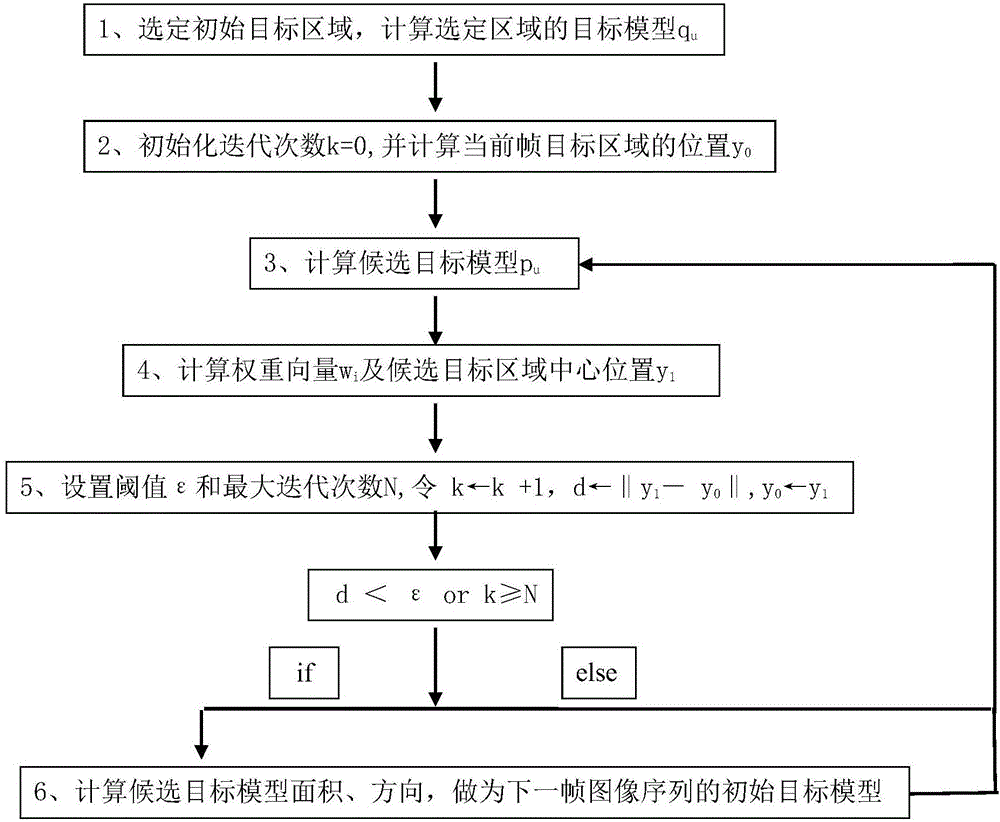Adaptive Mean Shift target tracking method based on LBP features
A target tracking and adaptive technology, applied in the field of computer vision and target tracking, can solve the problems that color features are sensitive to illumination changes, lack of target model update strategy, and cannot effectively identify tracking targets, etc.
- Summary
- Abstract
- Description
- Claims
- Application Information
AI Technical Summary
Problems solved by technology
Method used
Image
Examples
Embodiment 1
[0085] A scale-direction adaptive Mean Shift target tracking method that combines local binary features and color histograms. The corresponding schematic diagram of the tracking framework is as follows figure 1 As shown, the tracking method can be divided into three steps: object model generation, object scale orientation estimation and similarity measurement.
[0086] (1) Target model generation:
[0087] In the tracking method provided by the present invention, the target model is described by a joint histogram composed of local binary features and color features of the image, that is, using the color and texture features in the mask formed by the local binary mode to describe the target, constructing A target model for joint texture-color features.
[0088] (2) Similarity measure:
[0089] The Bhattacharyya coefficient is used to measure the similarity between the target model and the target candidate model. The Bhattacharyya coefficient represents the cosine value of th...
Embodiment 2
[0094] Combine below figure 1 1. The design principle introduces the scheme in embodiment 1 in detail, see the following description for details:
[0095] A scale-direction adaptive Mean Shift target tracking method that combines local binary features and color histograms. The schematic diagram corresponding to the tracking frame is as follows figure 1 As shown, object model generation, object scale orientation estimation and similarity measure. The specific implementation manners of these three parts will be described in detail below.
[0096] (1) Target model generation part:
[0097] The description of the target model in the tracking method provided by the present invention consists of a joint histogram composed of local binary features (LBP) and color features. The following is a detailed introduction on how to extract the local binary features of the target area.
[0098] Local Binary Pattern (LBP) is an operator used to describe the local texture features of the ima...
Embodiment 3
[0157] Below in conjunction with specific accompanying drawing, the scheme in embodiment 1 and 2 is carried out feasibility verification, see the following description for details:
[0158] The tracking method provided by the implementation of the present invention is used to track the video under the similar situation of 3 groups of illumination changes and background and target color, and compare it with the tracking result of the SOAMST algorithm under the same conditions, and the obtained partial tracking results are shown in Fig. ), (3), (4) shown.
[0159] In the video sequence shown in Figure (2), the wild goose and its surrounding areas are selected as the tracking target. The recognition of the target in the video is very low, and the scale direction of the wild goose is constantly changing during the tracking process. figure 2 (a) and (b) represent part of the tracking results obtained by the tracking algorithm provided by the present invention and the SOAMST algori...
PUM
 Login to View More
Login to View More Abstract
Description
Claims
Application Information
 Login to View More
Login to View More - R&D
- Intellectual Property
- Life Sciences
- Materials
- Tech Scout
- Unparalleled Data Quality
- Higher Quality Content
- 60% Fewer Hallucinations
Browse by: Latest US Patents, China's latest patents, Technical Efficacy Thesaurus, Application Domain, Technology Topic, Popular Technical Reports.
© 2025 PatSnap. All rights reserved.Legal|Privacy policy|Modern Slavery Act Transparency Statement|Sitemap|About US| Contact US: help@patsnap.com



